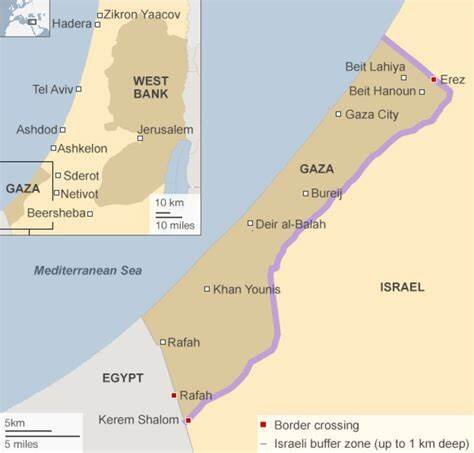Prospects of a buffer zone: Navigating tensions along the Israel-Gaza border

In the wake of the recent incursion along the Israel-Gaza border, discussions have reignited regarding the establishment of a buffer zone in the region. This potential measure is being considered to address the security challenges that have persisted since Israel's unilateral withdrawal in 2005.
Before the incursion, nearly all 400 residents of a kibbutz along the border had been evacuated, and their return remains uncertain. Eran Braverman, a 63-year-old farmer, shared his perspective, stating, "It is still not a place to go back to with children, not yet unfortunately. If there really would be such a (buffer) zone... it could help a lot. I hope it happens."
In 2005, Israel withdrew its troops and settlers from Gaza, terminating a presence dating back to 1967 while retaining significant control over the territory's borders. The idea of a buffer zone, which was initially considered but not implemented in the early 2000s, has resurfaced in the aftermath of the recent conflict.
Hellestveit, an expert on the region, notes, "With the war and the reoccupation of Gaza, this plan from when Israel last had control over Gaza militarily has come back on the table."
The proposal for a buffer zone involves creating a restricted area along the Israel-Gaza border, similar to Egypt's buffer zone on its side of the border. The hope is that such a measure could enhance security, allowing the displaced residents to return and fostering stability in the region.
As the discussions unfold, the potential establishment of a buffer zone stands as a crucial point in the ongoing efforts to navigate the complex dynamics between Israel and Gaza.
The plan, not publicly confirmed by Israel, appears to entail taking a significant chunk of territory out of the already tiny Gaza Strip, something experts as well as Israel's foreign allies have warned against.
Since Oct. 7, Israeli forces have targeted structures in Gaza within a kilometer (0.6 miles) of the border, said Adi Ben Nun, a professor at Hebrew University of Jerusalem who has carried out an analysis of satellite imagery according to Jerusalem Times.
More than 30% of all buildings in that area have been damaged or destroyed during the war, he said.
Further, "We are seeing mounting evidence that Israel appears to be rendering large parts of Gaza unlivable," said Nadia Hardman, a refugee rights expert at Human Rights Watch.
"One very clear example of that may be the buffer zone – this may amount to a war crime", she said.
Leave a Comment